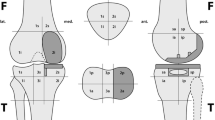Abstract
Objective
The purpose was to evaluate the intra- and inter-observer reliability of combined quantitative 3D-volumetric single-photon emission computed tomography (SPECT)/CT analysis including size, intensity and localisation of tracer uptake regions and total knee arthroplasty (TKA) position.
Materials and methods
Tc-99m-HDP-SPECT/CT of 100 knees after TKA were prospectively analysed. The anatomical areas represented by a previously validated localisation scheme were 3D-volumetrically analysed. The maximum intensity was recorded for each anatomical area. Ratios between the respective value and the mid-shaft of the femur as the reference were calculated. Femoral and tibial TKA position (varus–valgus, flexion–extension, internal rotation– external rotation) were determined on 3D-CT. Two consultant radiologists/nuclear medicine physicians interpreted the SPECT/CTs twice with a 2-week interval. The inter- and intra-observer reliability was determined (ICCs). Kappa values were calculated for the area with the highest tracer uptake between the observers.
Results
The measurements of tracer uptake intensity showed excellent inter- and intra-observer reliabilities for all regions (tibia, femur and patella). Only the tibial shaft area showed ICCs <0.89. The kappa values were almost perfect (0.856, p < 0.001; 95 % CI 0.778, 0.922). For measurements of the TKA position, there was strong agreement within and between the readings of the two observers; the ICCs for the orientation of TKA components for inter- and intra-observer reliability were nearly perfect (ICCs >0.84).
Conclusion
This combined 3D-volumetric standardised method of analysing the location, size and the intensity of SPECT/CT tracer uptake regions (“hotspots”) and the determination of the TKA position was highly reliable and represents a novel promising approach to biomechanics.



Similar content being viewed by others
References
Bybel B, Brunken RC, DiFilippo FP, Neumann DR, Wu G, Cerqueira MD. SPECT/CT imaging: clinical utility of an emerging technology. Radiographics. 2008;28(4):1097–113.
Delbeke D, Schöder H, Martin WH, Wahl RL. Hybrid imaging (SPECT/CT and PET/CT): Improving therapeutic decisions. Semin Nucl Med. 2009;39(5):308–40.
Gnanasegaran G, Barwick T, Adamson K, Mohan H, Sharp D, Fogelman I. Multislice SPECT/CT in benign and malignant bone disease: when the ordinary turns into the extraordinary. Semin Nucl Med. 2009;39(6):431–42.
Hirschmann MT, Konala P, Iranpour F, Kerner A, Rasch H, Friederich NF. Clinical value of SPECT/CT for evaluation of patients with painful knees after total knee arthroplasty–a new dimension of diagnostics? BMC Musculoskelet Disord. 2011;12:36.
Hirschmann MT, Schmid R, Dhawan R, et al. Combined single photon emission computerized tomography and conventional computerized tomography: clinical value for the shoulder surgeons? Int J Shoulder Surg. 2011;5(3):72–6.
Konala P, Iranpour F, Kerner A, Rasch H, Friederich NF, Hirschmann MT. Clinical benefit of SPECT/CT for follow-up of surgical treatment of osteochondritis dissecans. Ann Nucl Med. 2010;24(8):621–4.
Scharf S. SPECT/CT imaging in general orthopedic practice. Semin Nucl Med. 2009;39(5):293–307.
Hirschmann MT, Iranpour F, Konala P, et al. A novel standardized algorithm for evaluating patients with painful total knee arthroplasty using combined single photon emission tomography and conventional computerized tomography. Knee Surg Sports Traumatol Arthrosc. 2010;18(7):939.
Graute V, Feist M, Lehner S, et al. Detection of low-grade prosthetic joint infections using 99mTc-antigranulocyte SPECT/CT: initial clinical results. Eur J Nucl Med Mol Imaging. 2010;37(9):1751–9.
Hirschmann MT, Davda K, Iranpour F, Rasch H, Friederich NF. Combined single photon emission computerised tomography and conventional computerised tomography (SPECT/CT) in patellofemoral disorders: a clinical review. Int Orthop. 2011;35(5):675–80.
Hirschmann MT, Iranpour F, Davda K, Rasch H, Hugli R, Friederich NF. Combined single-photon emission computerized tomography and conventional computerized tomography (SPECT/CT): clinical value for the knee surgeons? Knee Surg Sports Traumatol Arthrosc. 2010;18(3):341–5.
Ahmad R, Kumar GS, Katam K, Dunlop D, Pozo JL. Significance of a "hot patella" in total knee replacement without primary patellar resurfacing. Knee. 2009;16(5):337–40.
Pagenstert GI, Barg A, Leumann AG, et al. SPECT-CT imaging in degenerative joint disease of the foot and ankle. J Bone Joint Surg Br. 2009;91(9):1191–6.
Hirschmann MT, Wagner CR, Rasch H, Henckel J. Standardized volumetric 3D-analysis of SPECT/CT imaging in orthopaedics: overcoming the limitations of qualitative 2D analysis. BMC Med Imaging. 2012;12(1):5.
Hirschmann MT, Konala P, Amsler F, Iranpour F, Friederich NF, Cobb JP. The position and orientation of total knee replacement components: a comparison of conventional radiographs, transverse 2D-CT slices and 3D-CT reconstruction. J Bone Joint Surg Br Vol. 2011;93(5):629–33.
Henckel J, Richards R, Lozhkin K, et al. Very low-dose computed tomography for planning and outcome measurement in knee replacement. The imperial knee protocol. JBJS (Br). 2006;88(11):1513–8.
Walter SD, Eliasziw M, Donner A. Sample size and optimal designs for reliability studies. Stat Med. 1998;17(1):101–10.
Landis JR, Koch GG. The measurement of observer agreement for categorical data. Biometrics. 1977;33(1):159–74.
Acknowledgements
We greatly thank the Gottfried und Julia Bangerter-Rhyner-Stiftung, Berne, Switzerland as well as the Deutsche Arthrose Hilfe e.V, Saarlouis, Germany for supporting our research.
Conflict of interest
The authors declare that they have no conflict of interest.
Author information
Authors and Affiliations
Corresponding author
Rights and permissions
About this article
Cite this article
Rasch, H., Falkowski, A.L., Forrer, F. et al. 4D-SPECT/CT in orthopaedics: a new method of combined quantitative volumetric 3D analysis of SPECT/CT tracer uptake and component position measurements in patients after total knee arthroplasty. Skeletal Radiol 42, 1215–1223 (2013). https://doi.org/10.1007/s00256-013-1643-2
Received:
Revised:
Accepted:
Published:
Issue Date:
DOI: https://doi.org/10.1007/s00256-013-1643-2




